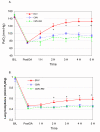A comparison of biologically variable ventilation to recruitment manoeuvres in a porcine model of acute lung injury
- PMID: 15563376
- PMCID: PMC535805
- DOI: 10.1186/1465-9921-5-22
A comparison of biologically variable ventilation to recruitment manoeuvres in a porcine model of acute lung injury
Abstract
Background: Biologically variable ventilation (return of physiological variability in rate and tidal volume using a computer-controller) was compared to control mode ventilation with and without a recruitment manoeuvre - 40 cm H2O for 40 sec performed hourly; in a porcine oleic acid acute lung injury model.
Methods: We compared gas exchange, respiratory mechanics, and measured bronchoalveolar fluid for inflammatory cytokines, cell counts and surfactant function. Lung injury was scored by light microscopy. Pigs received mechanical ventilation (FIO2 = 0.3; PEEP 5 cm H2O) in control mode until PaO2 decreased to 60 mm Hg with oleic acid infusion (PaO2/FIO2 <200 mm Hg). Additional PEEP to 10 cm H2O was added after injury. Animals were randomized to one of the 3 modes of ventilation and followed for 5 hr after injury.
Results: PaO2 and respiratory system compliance was significantly greater with biologically variable ventilation compared to the other 2 groups. Mean and mean peak airway pressures were also lower. There were no differences in cell counts in bronchoalveolar fluid by flow cytometry, or interleukin-8 and -10 levels between groups. Lung injury scoring revealed no difference between groups in the regions examined. No differences in surfactant function were seen between groups by capillary surfactometry.
Conclusions: In this porcine model of acute lung injury, various indices to measure injury or inflammation did not differ between the 3 approaches to ventilation. However, when using a low tidal volume strategy with moderate levels of PEEP, sustained improvements in arterial oxygen tension and respiratory system compliance were only seen with BVV when compared to CMV or CMV with a recruitment manoeuvre.
Figures



References
-
- Marini JJ. How to recruit the injured lung. Minerva Anestesiol. 2003;69:193–200. - PubMed
-
- Grasso S, Mascia L, Del Turco M, Malacarne P, Giunta F, Brochard L, Slutsky AS, Marco Ranieri V. Effects of recruiting maneuvers in patients with acute respiratory distress syndrome ventilated with protective ventilatory strategy. Anesthesiology. 2002;96:795–802. doi: 10.1097/00000542-200204000-00005. - DOI - PubMed
-
- Rouby JJ, Lu Q, Goldstein I. Selecting the right level of positive end-expiratory pressure in patients with acute respiratory distress syndrome. Am J Respir Crit Care Med. 2002;165:1182–1186. - PubMed
Publication types
MeSH terms
Substances
LinkOut - more resources
Full Text Sources
Medical

